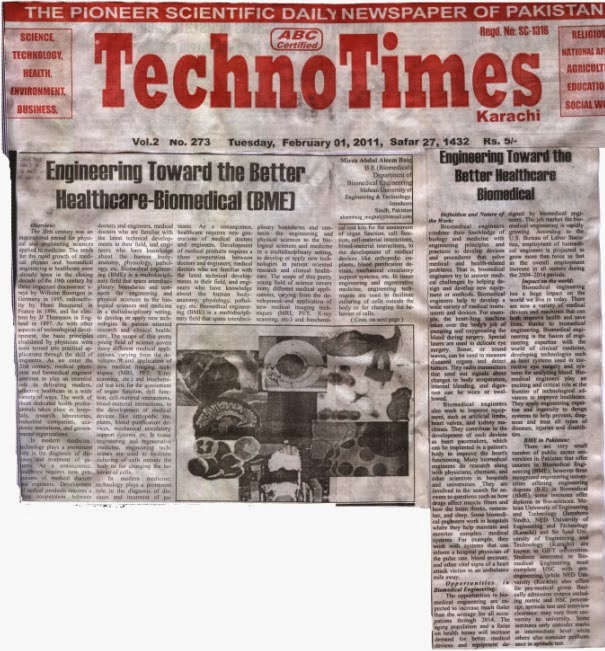Engineering Toward the Better Healthcare-Biomedical (BME)
Overview:
The 20th century was an inspirational period for physical and engineering sciences applied to medicine. The seeds for the rapid growth of medical physics and biomedical engineering in healthcare were already sown in the closing decade of the 19th century by three important discoveries: x-rays by Wilhelm Roentgen in Germany in 1895, radioactivity by Henri Becquerel in France in 1896, and the electron by JJ Thompson in England
Background:
In modern medicine, technology plays a prominent role in the diagnosis of diseases and treatment of patients. As a consequence, healthcare requires new generations of medical doctors and engineers. Development of medical products requires a close cooperation between doctors and engineers, medical doctors who are familiar with the latest technical developments in their field, and engineers who have knowledge about the human body-anatomy, physiology, pathology, etc. Biomedical engineering (BME) is a multidisciplinary field that spans interdisciplinary boundaries and connects the engineering and physical sciences to the biological sciences and medicine in a multidisciplinary setting, to develop or apply new technologies in patient oriented research and clinical healthcare. The scope of this pretty young field of science covers many different medical applications, varying from the development and application of new medical imaging techniques (MRI, PET, X-ray scanning, etc.) and biochemical test kits for the assessment of organ function, cell function, cell-material interactions, blood-material interactions, to the development of medical devices like orthopedic implants, blood purification devices, mechanical circulatory support systems, etc. In tissue engineering and regenerative medicine, engineering techniques are used to facilitate culturing of cells outside the body or for changing the behavior of cells.
Definition and Nature of the Work:
Biomedical engineers combine their knowledge of biology and medicine with engineering principles and practices to develop devices and procedures that solve medical and health-related problems. That is, biomedical engineers try to answer medical challenges by helping design and develop new equipment or methods. Biomedical engineers help to develop a wide variety of medical instruments and devices. For example, the heart-lung machine takes over the body's job of pumping and oxygenating the blood during surgery. Special lasers are used in delicate eye surgery. Sonar, or sound waves, can be used to measure diseased organs and detect tumors. Tiny radio transmitters that send out signals about changes in body temperature, internal bleeding, and digestion can be worn or swallowed. Biomedical engineers also work to improve equipment, such as artificial limbs, heart valves, and kidney machines. They contribute to the development of such devices as heart pacemakers, which can be implanted in a patient's body to improve the heart's functioning. Many biomedical engineers do research along with physicians, chemists, and other scientists in hospitals and universities. They are involved in the search for answers to questions such as how drugs affect muscle fibers and how the brain thinks, remember, and sleep. Some biomedical engineers work in hospitals where they help maintain and monitor complex medical systems. For example, they work with systems that can inform a hospital physician of the pulse rate, blood pressure, and other vital signs of a heart attack victim in an ambulance mile away.
Opportunities in Biomedical Engineering:
The opportunities in biomedical engineering are expected to increase much faster than the average for all occupations through 2014. The aging population and a focus on health issues will increase demand for better medical devices and equipment designed by biomedical engineers. The job market for biomedical engineering is rapidly growing. According to the U.S. Bureau of Labor Statistics, employment of biomedical engineers is projected to grow more than twice as fast as the overall employment increase in all sectors during the 2004–2014 periods.
Impact on the world:
Biomedical engineering has a huge impact on the world we live in today. There are now a variety of medical devices and machines that can both improve health and save lives, thanks to biomedical engineering. Biomedical engineering is the fusion of engineering expertise with the world of clinical medicine, developing technologies such as laser systems used in corrective eye surgery and systems for analyzing blood. Biomedical engineers play an exciting and critical role at the frontier of technological advances to improve healthcare. They apply engineering expertise and ingenuity to design systems to help prevent, diagnose and treat all types of diseases, injuries and disabilities.


“Engineering Towards Better Healthcare-Biomedical” (BME),This article was published in leading scientific newspaper "Techno Times Karachi" Vol.2 No. 273 Tuesday, February 01, 2011.
ReplyDelete